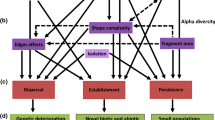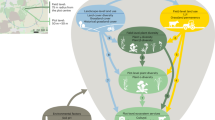Abstract
Ecosystem engineers are organisms that change the distribution of materials and energy in the abiotic environment, usually creating and maintaining new habitat patches in the landscape. Such changes in habitat conditions have been widely documented to affect the distributions and performances of other species but up to now no studies have addressed how such effects can impact the biotically driven physicochemical processes associated with these landscapes, or ecosystem functions. Based on the widely accepted positive relationship between species diversity and ecosystem functions, we propose that the effects of ecosystem engineers on other species could have an impact on ecosystem functions via two mutually inclusive mechanisms: (1) by adding new species into landscapes, hence increasing species diversity; and (2) by improving the performances of species already present in the landscape. To test these hypotheses, we focused on the effects of a high-Andean ecosystem engineer, the cushion plant Azorella monantha, by comparing the accumulation of plant biomass and nitrogen fixed in plant tissues as species richness increases in landscapes with and without the engineer species. Our results show that both ecosystem functions increased with species richness in both landscape types, but landscapes including A. monantha cushions reached higher outcomes of plant biomass and nitrogen fixed in plant tissues than landscapes without cushions. Moreover, our results indicate that such positive effects on ecosystem functions could be mediated by the two mechanisms proposed above. Then, given the conspicuousness of ecosystem engineering in nature and its strong influence on species diversity, and given the well-known relationship between species diversity and ecosystem function, we suggest that the application of the conceptual framework proposed herein to other ecosystems would help to advance our understanding of the forces driving ecosystem functioning.




Similar content being viewed by others
References
Aarssen LW, Laird RA, Pither J (2003) Is the productivity of vegetation plots higher or lower when there are more species? Variable predictions from interaction of the ‘sampling effect’ and ‘competitive dominance effect’ on the habitat templet. Oikos 102:427–432
Aho K, Huntly N, Moen J, Oksanen T (1998) Pikas (Ochotona princeps: Lagomorpha) as allogenic engineers in an alpine ecosystem. Oecologia 114:405–409
Arroyo MTK, Cavieres LA, Peñaloza A, Arroyo-Kalin MA (2003) Positive interactions between the cushion plat Azorella monantha (Apiaceae) and alpine plant species in the Chilean Patagonian Andes. Plant Ecol 169:121–129
Badano EI, Molina-Montenegro MA, Quiroz CL, Cavieres LA (2002) Efectos de la planta en cojín Oreopolus glacialis (Rubiaceae) sobre la riqueza y diversidad de especies en una comunidad alto-andina de Chile central. Rev Chil Hist Nat 75:757–765
Badano EI, Cavieres LA (2006a) Ecosystem engineering across ecosystems: do engineer species sharing common features have generalized or idiosyncratic effects on species diversity? J Biogeogr 33:304–313
Badano EI, Cavieres LA (2006b) Impacts of ecosystem engineers on community attributes: effects of cushion plants at different elevations of the Chilean Andes. Divers Distrib 12:388–396
Badano EI, Jones CG, Cavieres LA, Wright JP (2006) Assessing impacts of ecosystem engineers on community organization: a general approach illustrated by effects of a high-Andean cushion plant. Oikos 115:369–385
Badano EI, Villarroel E, Bustamante RO, Marquet P, Cavieres LA (2007) Ecosystem engineering facilitates invasions by exotic plants in high-Andean ecosystems. J Ecol 95:682–688
Borthagaray AI, Carranza A (2007) Mussels as ecosystem engineers: Their contribution to species richness in a rocky littoral community. Acta Oecol 31:243–250
Cardinale BJ, Palmer MA, Collins SL (2002) Species diversity enhances ecosystem functioning through interspecific facilitation. Nature 415:426–429
Castilla JC, Lagos NA, Cerda M (2004) Marine ecosystem engineering by the alien ascidian Pyura praeputialis on a mid-intertidal rocky shore. Mar Ecol Prog Ser 268:119–130
Cavieres LA, Peñaloza A, Papic C, Tambutti M (1998) Efecto nodriza del cojín Laretia acaulis (Umbelliferae) en la zona alto-andina de Chile central. Rev Chil Hist Nat 71:337–347
Cavieres LA, Arroyo MTK (1999) Tasa de enfriamiento adiabático del aire en la cuenca del Rio Molina, Provincia de Santiago, Chile central (33°S). Rev Geográfica Chile Terra Australis 44:79–86
Cavieres LA, Arroyo MTK, Peñaloza A, Molina-Montenegro MA, Torres C (2002) Nurse effect of Bolax gummifera cushion plants in the alpine vegetation of the Chilean Patagonian Andes. J Veg Sci 13:547–554
Cavieres LA, Quiroz CL, Molina-Montenegro MA, Muñoz AA, Pauchard A (2005) Nurse effect of the native cushion plant Azorella monantha on the invasive non-native Taraxacum officinale in the high-Andes of central Chile. Perspect Plant Ecol Evol Syst 7:217–226
Cavieres LA, Badano EI, Sierra-Almeida A, Gómez-González S, Molina-Montenegro MA (2006) Positive interactions between alpine plant species and the nurse cushion plant Laretia acaulis do not increase with elevation in the Andes of central Chile. New Phytol 169:59–69
Cavieres LA, Badano EI, Sierra-Almeida A, Molina-Montenegro MA (2007) Microclimatic modifications of cushion plants and their consequences for seedling survival of native and non-native herbaceous species in the high Andes of central Chile. Arct Antarct Alp Res 39:229–236
Chapin III FS, Walker BH, Hobbs RJ, Hooper DU, Lawton JH, Sala OE, Tilman D (1997) Biotic control over the functioning of ecosystems. Science 227:500–504
Crooks JA, Khim HS (1999) Architectural vs. biological effects of a habitat-altering, exotic mussel, Musculista senhousia. J Exp Mar Biol Ecol 240:53–75
Flecker AS (1996) Ecosystem engineering by a dominant detritivore in a diverse tropical stream. Ecology 77:1845–1854
Fonseca CR, Ganade G (2001) Species functional redundancy, random extinctions and the stability of ecosystems. J Ecol 89:118–125
Fritz KM, Gangloff MM, Feminella JW (2004) Habitat modification by the stream macrophyte Justicia americana and its effects on biota. Oecologia 140:388–397
Giller PS, O’Donovan G (2002) Biodiversity and ecosystem function: do species matter? P Roy Irish Acad B 102:129–139
Gutiérrez JL, Jones CG (2006) Physical ecosystem engineers as agents of biogeochemical heterogeneity. Bioscience 56:227–236
Hector A, Schmid B, Beierkuhnlein C, Caldeira MC, Dimer M, Dimitrakopoulos PG, Finn JA, Freitas H, Giller PS, Good J, Harris R, Högberg P, Huss-Danell K, Joshi J, Jumpponen A, Körner C, Leadley PW, Loreau M, Minns A, Mulder CPH, O’Donovan G, Otway SJ, Pereira JS, Prinz A, Reed DJ, Scherer-Lorenzen M, Schulze ED, Siamantziouras ASD, Sphen EM, Terry AC, Troumbis AY, Woodward FI, Yachi S, Lawton JH (1999) Plant diversity and productivity experiments in European grasslands. Science 286:1123–1127
Hood GM (2006) PopTools [2.7.5]. http://www.cse.csiro.au/poptools. Accessed 27 December 2007
Huston MA (1997) Hidden treatments in ecological experiments: re-evaluating the ecosystem function of biodiversity. Oecologia 110:449–460
Jones CG, Lawton JH, Shachak M (1994) Organisms as ecosystem engineers. Oikos 69:373–386
Jones CG, Lawton JH, Shachak M (1997) Positive and negative effects of organisms as physical ecosystem engineers. Ecology 78:1946–1957
Kleier C, Rundel PW (2004) Microsite requirements, population structure and growth of the cushion plant Azorella compacta in the tropical Chilean Andes. Austral Ecol 29:461–470
Le Roux PC, McGeoch MA (2004) The use of size as an estimator of age in the subantarctic cushion plant, Azorella selago (Apiaceae). Arct Antarct Alp Res 36:509–517
Lill JT, Marquis RJ (2004) Leaf ties as colonization sites for forest arthropods: an experimental study. Ecol Entomol 29:300–308
Loreau M (1998) Biodiversity and ecosystem functioning: a mechanistic model. Proc Natl Acad Sci USA 95:5632–5636
Loreau M, Hector A (2001) Partitioning selection and complementarity in biodiversity experiments. Nature 412:72–76
Mark AF, Wilson JB (2005) Tempo and mode of vegetation dynamics over 50 years in a New Zealand alpine cushion/tussock community. J Veg Sci 16:227–236
Millennium Ecosystem Assessment (2005) Ecosystems and human well-being: biodiversity synthesis. World Resources Institute, Washington, DC
Molina-Montenegro MA, Badano EI, Inostroza P, Cavieres LA (2005) Intercambio gaseoso en dos especies de plantas alto andinas de Chile central: efecto de la asociación a plantas en cojín. Ecol Austral 15:49–58
Molina-Montenegro MA, Badano EI, Cavieres LA (2006) Cushion plants as microclimatic shelters for two ladybird beetles species in alpine zone of central Chile. Arct Antarct Alp Res 38:224–227
Moore JW (2006) Animal ecosystem engineers in streams. BioScience 56:237–246
Mulder CPH, Uliassi DD, Doak FD (2001) Physical stress and diversity-productivity relationships: the role of positive interactions. Proc Natl Acad Sci USA 98:6704–6708
Naeem S, Thomson LJ, Lawler SP, Lawton JH, Woodfin RM (1995) Empirical evidence that declining species diversity may alter the performance of terrestrial ecosystems. Phil T Roy Soc Lond B 347:249–242
Neira C, Levin LA, Grosholz ED (2005) Benthic macrofaunal communities of three sites in San Francisco Bay invaded by hybrid Spartina, with comparison to uninvaded habitats. Mar Ecol Prog Ser 292:111–126
Neira C, Grosholz ED, Levin LA, Blake R (2006) Mechanisms generating modification of benthos following tidal flat invasion by a Spartina hybrid. Ecol Appl 16:1391–1404
Núñez C, Aizen M, Ezcurra C (1999) Species associations and nurse plant effect in patches of high-Andean vegetation. J Veg Sci 10:357–364
Perelman SB, Burkart SE, Leon RJC (2003) The role of a native tussock grass (Paspalum quadrifarium Lam.) in structuring plant communities in the Flooding Pampa grasslands, Argentina. Biodivers Conserv 12:225–238
Petchey OL (2004) On the statistical significance of functional diversity effects. Funct Ecol 18:297–303
Ralph CP (1978) Observations on Azorella compacta (Umbelliferae), a tropical Andean cushion plant. Biotropica 10:62–67
Santibáñez F, Uribe JM (1990) Atlas agroclimático de la V Región y Región Metropolitana. Universidad de Chile, Santiago de Chile, Chile
Schooley RL, Bestelmeyer BT, Kelly JF (2000) Influence of small-scale disturbances by kangaroo rats on Chihuahuan Desert ants. Oecologia 125:142–149
Thomas F, Renaurd F, de Meeûs T, Poulin R (1998) Manipulation of host behavior by parasites: ecosystem engineering in the intertidal zone? Proc Roy Soc Lond B 265:1091–1096
Tilman D, Knops J, Wedin D, Reich P, Ritchie M, Siemann E (1997) The influence of functional diversity and composition on ecosystem processes. Science 277:1300–1302
Wright JP, Jones CG, Flecker AS (2002) An ecosystem engineer, the beaver, increases species richness at the landscape scale. Oecologia 132:96–101
Wright JP, Jones CG (2006) The concept of organisms as ecosystem engineers ten years on: progress, limitations, and challenges. Bioscience 56:203–209
Acknowledgments
We thank the staff of the La Parva and Valle Nevado ski centers for logistic support provided during the sampling season. We acknowledge the financial support of the project FONDECYT 3060095 (EIB) and the projects FONDAP-FONDECYT 1501-0001 and ICM P05-002 (PAM). Part of this work was conducted while PAM was a Sabbatical Fellow at the National Center for Ecological Analysis and Synthesis, a Center funded by the NSF (Grant #DEB-0072909), the University of California, and the Santa Barbara campus. All of the experiments presented in this study comply with the current laws of the country in which they were performed.
Author information
Authors and Affiliations
Corresponding author
Additional information
Communicated by Jon Keeley.
Electronic supplementary material
Below is the link to the electronic supplementary material.
Appendix S1
. Species from Mt. Franciscano and Mt. Tres Puntas. Species were classified according to the habitat type in which they were found. Cushions: species were only detected within Azorella monantha cushions; open areas: species were only detected in unmodified open areas surrounding cushions; both: species were detected in both habitat types. Absent indicates species not detected on a given mountaintop (doc 60 KB)
Rights and permissions
About this article
Cite this article
Badano, E.I., Marquet, P.A. Ecosystem engineering affects ecosystem functioning in high-Andean landscapes. Oecologia 155, 821–829 (2008). https://doi.org/10.1007/s00442-007-0953-2
Received:
Accepted:
Published:
Issue Date:
DOI: https://doi.org/10.1007/s00442-007-0953-2




